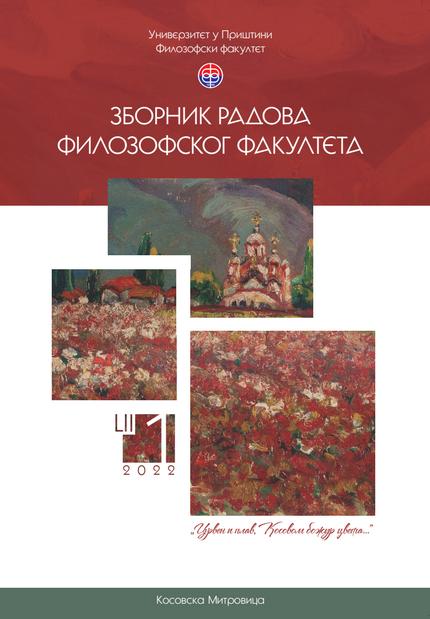Directed Communicative Modelling as an ESP Teaching Strategy at Tertiary Level: Recontextualization and Other Issues
Abstract
The paper presents an innovative “text-and-context” teaching methodology applied to develop multiple language and professional competencies in the LSP university classroom. We take the established principles of Directed Communicative Modelling (Dressen-Hammouda, 2003) and implement them into an LSP course for Optometrists which is a three-year Bachelor program of applied (vocational) studies offered by the Physics Department at the Faculty of Sciences in Novi Sad. The presented LSP course for optometrists constitutes the following language segments: medical English, occupational English, technical English and English for academic purposes, with a complex range of contextual specifications attached. Consequently, the present approach relies as much on building contextual knowledge as it does on building language and textual competencies. Having a specialized language competence is therefore principally about learning to manipulate and creatively and inventively recreate language structure within a proper context attached to its use. The power of the proposed teaching methodology lies in its potential constructing of the wide range of specialized knowledge structures involved in professional language communicative situations.
The aim of the present study is twofold: to describe and explain a localized and recontextualized version of Directed Communicative Modelling, which is a largely Anglo-Saxon teaching practice, into the Serbian university system and to report on the defined practical outcomes of such an approach for the course were the main learning objectives for the students include (among others) the full capacity for independent professional work in the field of optics and optometry and reading the relevant literature in English as well as conducting academic and professional research. We conclude that, as a principled and defined teaching strategy, Directed Communicative Modelling integrates assumptions about both linguistic and social conditions for specialized discourses while aiming to get students to understand how to best use language as an effective and powerful textual and contextual tool.
References
Миливојевић, Н. и Радојичић, С. (2016). Текстуална компетенција, (интер)текстуалност и настава страних језика на универзитетском нивоу у контексту евроинтеграција. У: Д. Мастиловић (ур.), Наука и евроинтеграције (323–339). Пале: Филозофски факултет Универзитета у Источном Сарајеву.
Askehave, I. & Swales, J. (2001). Genre Identification and Communicative Purpose: A Problem and a Possible Solution. Applied Linguistics, 22 (2), 195–212.
Dressen-Hammouda, D. F. (2002). Identifying Textual Silence in Scientific Research Articles: Recontextualizations of the Field Account in Geology. Hermes, Journal of Linguistics, 28, 81–107.
Dressen-Hammouda, D. (2003). Contributions of an Integrated Genre Theory of Text and Context to Teaching LSP. La Revue du Geras ASP, Varia, 39–40 (79), 73–90.
Horner, B. (1999). The ‘Birth’ of Basic Writing. In: B. Horner & M.-Z. Lu (Eds.), Representing the ‘Other’. Basic Writers and the Teaching of Basic Writing (3–29). Urbana, Illinois: NCTE.
Lillis, M. & Scott, T. (2007). “Defining Academic Literacies Research: Issues of Epistemology, Ideology and Strategy”. Journal of Applied Linguistics, 4, 5–32.
Linell, P. (1998). Discourse Across Boundaries: On Recontextualizations and the Blending of Voices in Professional Discourse. Text, 18 (2), 143–157.
Martin, J. (1993). Literacy in Science: Learning to Handle Text as Technology. In: M. A. K. Halliday (Ed.), Writing Science. Literacy and Discursive Power. Falmer Press: Bristol, PA.
Milivojević, N. (2019). Self-promotion Rhetoric and (Meta)discourse in Academic Writing – a Contrastive Study. In: P. Vičič, N. Gajšt, A. Plos (Еds.), Proceedings of the 10th International Language Conference on the Importance of Learning Professional Foreign Languages for Communication Between Cultures (273–283). Maribor: University of Maribor Press.
Milivojević, N. & Radojičić, S. (2015a). Enhancing Intercultural Competence Through Genre and Culture Markers in Textual Analysis. In: T. Kužič, D. Pleše, A. Plićanić Mesić (Eds.), Proceedings of the 8th International Language Conference On the Importance of Learning Professional Foreign Languages for Communication Between Cultures (145–155). Croatia: University of Zagreb.
Milivojević, N. & Radojičić, S. (2015b). Chapter Seven:“Types of Cohesion and Hedging Devices in Scientific Texts – a Classroom Perspective” In: I. Lakić, B. Živković, M. Vuković (Eds.) Academic Discourse Across Cultures (114-129). Cambridge: Cambridge Scholars Publishing.
Pym, A. (2010). Exploring Translation Theories. New York: Routledge.
Russell, D. (1997). Rethinking Genre in School and Society: An Activity Theory Analysis. Written Communication, 14, 504–554.
Swales, J. (1990). Genre Analysis: English in Academic and Research Ssettings. Cambridge: Cambridge University Press.
Swales, J. (1992). Language for Specific Purposes. In: W. Bright (Ed.), International Encyclopaedia of Linguistics 2 (300). Oxford: Oxford University Press.
Swales, J. M. (2004). Research Genres. New York: Cambridge University Press.
The details about the publication policy, including copyright and licensing, are available at:

